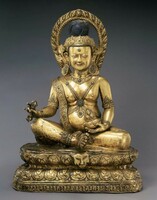Tsang Nyon Heruka Main Page - Updated

Tsang Nyon Heruka (1452-1507), author, teacher and yogi, in mahasiddha appearance.
Tsang Nyon (gtsang smyon he ru ka), be it painting or sculpture, typically appears as a Tantric yogi holding a vajra scepter in the extended right hand, or alternately raised, and a skullcup in the left hand with a katvanga staff leaning against the left shoulder. His robe is generally white as is the custom of those following the tradition of Milarepa and Rechungpa. As ornaments he wears a skull headdress and bone earrings, necklace, long and short, bracelets, anklets, all modelling the appearance of the semi-peaceful and semi-wrathful deities like Hevajra and Chakrasamvara of the Anuttarayoga class of Buddhist Tantra. This is known as Mahasiddha Appearance. This peculiar and anti-social manner of dressing, copying a Heruka deity, is called the second level of the Application of the Vow in the Hevajra Tantra. The Chakrasamvara and Hevajra Tantras principally, along with similar instructions in other Tantras, are the textual source for all of those teachers and practitioners in India and Tibet who wear bone ornaments, animal skins and hold Tantric implements.
Tsang Nyon is famous for his appearance and his writings. After extensive retreats he insisted on wearing the Heruka attire as stipulated in the Chakrasamvara and Hevajra Tantras. He is however more well known for writing and compiling the One Hundred Thousand Songs of Milarepa along with numerous biographies of early Kagyu teachers. In the 15th century he set about to revive the old Marpa Kagyu traditions of extensive retreats in isolated locations following after the conduct of Milarepa.
